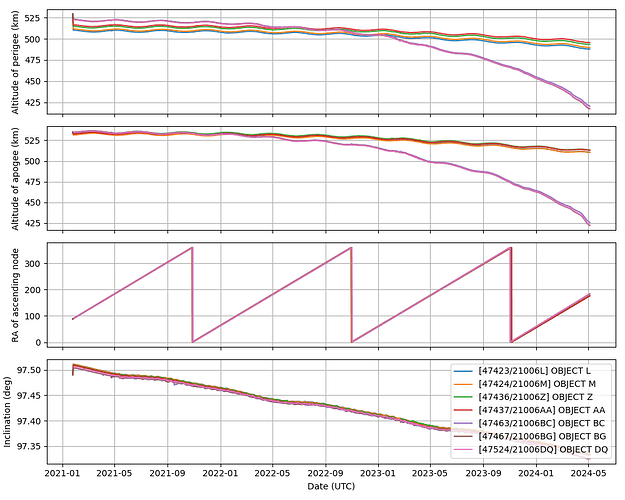As far as I can tell, the three VR3X satellites were launched on 24th January 2021 and had an expected lifespan of 3 months. As they are most likely now orbital dust, can they be marked as ‘Inactive’ now in the database?
It looks like that the random OBJECTS/NORAD IDs we had assigned for them are still in orbit.
@blackeye is this 3-month lifespan for the orbit or for the functionality of the satellite?
Also, do you know if any of the VR3X was identified? If not, do we now possible NORAD IDs due to other characteristics (size, deployment altitude)?
If we have more info we can change them in the DB and mark them as inactive or even re-entered.
Searching about this satellite, and after a quick check on Transporter 1 launch, on space-track.org, celestrak.org and on our data in the related thread. It seems that the non-identified satellites from this launch are all still in orbit:
We have three on them, BC, BG and DQ to be decaying quicker than the others. By the way these three are the ones we currently follow for VR3X satellites.
Another clue that these satellites weren’t expected to decay soon, is this presentation, in which at page 11 says that the mission was calculated from 3 to 11 months but the de-orbit was calculated ~13 years.
In the same presentation there isn’t a solid identification of the satellites, the possible objects are the ones we follow in DB, which means that probably the satellite team was based on our random choice or vice versa. Unfortunately back then we didn’t keep track how we choose these NORAD IDs to follow.
Here are some scenarios:
-
In presentation there is a typo and de-orbit was calculated as 13 months instead of years, in this scenario we would expect to see satellites from this launch be decayed around January 2022. Indeed we have 10 satellites decaying at that period, however all were identified as STARLINKs and probably as STARLINKs usually are not expected to be decayed so quickly, I guess this probably was an experiment to test de-orbiting. Of course we need to find more data to verify that these specific STARLINKs were under such a test, or data the prove that the identification of all these STARLINKs was right.
-
In presentation there is a mis-calculation of the de-orbit period. In this scenario, VR3X satellites could be 3 of the 66 decayed satellites until now (excluding the STARLINKs from the previous scenario), which however have been identified in space-track.org, probably by the teams. Again in this case we face the mis-identification scenario, so in order to verify it, we need to make sure that the 13 years in the presentation was mis-calculated and that 3 of the identifications were not correct.
-
Similar to the 2nd scenario, we have a mis-calculation but the satellites are still in orbit. In this scenario we need data to know that all the identification are correct.
3.1. Identifications are correct, then the satellites are probably the ones we follow, as the decaying rate shows that they will not last near 13 years (note: based on just a projection on the diagram above)
3.2. Identifications are wrong, then the satellites are one of those in orbit that getting close to re-enter. -
In this scenario the calculation of the 13 years is correct in presentation, so we have the satellites in orbit. As in the previous scenario, in this case we again need data to verify the identifications are correct.
4.1. Identifications are correct, then the satellites are probably one of the unknown that are visible in the diagram above, but not the ones we currently follow.
4.2 Identifications are wrong, then three of the identified satellites that aren’t near to re-enter are the VR3X satellites.
Unfortunately without public data it is difficult to support any of the above scenarios, so for now I’ll guess we will continue to follow the specific NORAD IDs for these satellites until they decay.
Thanks for your in-depth research Fredy. In the post mission presentation that you linked, the team state that the release after launch on 21st January 2021 did not go according to plan and that the satellites were proven to be tumbling fast. This might explain an orbit decay way below the stated 13 years if they were released at the wrong velocity and/or the wrong direction, fitting your scenario 3 well. It’s a shame we can’t just pop up there and take a look! Now there’s a market opportunity … !
According to the team:
VR3X-A, also known as “Littlefoot”, has the NORAD ID 47463 (Object BC) SatNOGS: 99750
VR3X-B, “Petrie”, has the NORAD ID 47467 (Object BG) SatNOGS: 99751
VR3X-C, “Cera”, has the NORAD ID 47524 (Object DQ) SatNOGS: 99752
The tumbling of course prevented the solar panels from supplying enough power to keep the batteries charged and communication stopped much earlier than planned/hoped. The TinsGS community received packets while the satellites were operational, the last packets being received in late January/early February 2021. Although current data shows them still orbiting, they can certainly be marked as “inactive” as a ‘return to life’ is technically almost impossible. Interesting!
